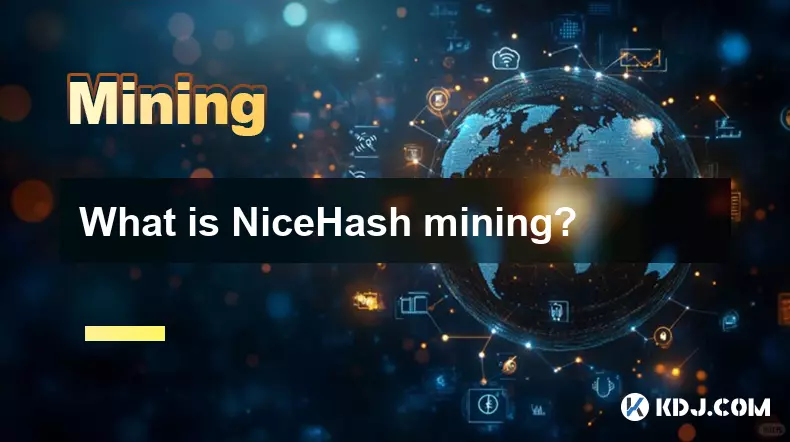-
 bitcoin
bitcoin $101752.865364 USD
-1.09% -
 ethereum
ethereum $3382.985899 USD
-1.38% -
 tether
tether $0.999658 USD
0.04% -
 xrp
xrp $2.272505 USD
-1.51% -
 bnb
bnb $989.089004 USD
0.14% -
 solana
solana $156.962612 USD
-3.08% -
 usd-coin
usd-coin $0.999776 USD
0.01% -
 tron
tron $0.290786 USD
-0.69% -
 dogecoin
dogecoin $0.174594 USD
-2.86% -
 cardano
cardano $0.560085 USD
-3.55% -
 hyperliquid
hyperliquid $40.023704 USD
-5.75% -
 chainlink
chainlink $15.324649 USD
-2.78% -
 bitcoin-cash
bitcoin-cash $493.576540 USD
-3.52% -
 zcash
zcash $571.320038 USD
-12.05% -
 stellar
stellar $0.280066 USD
-4.26%
How does proof-of-work mining function?
Proof-of-work mining secures blockchains by requiring computational effort to solve puzzles, ensuring decentralization, trust, and resistance to tampering.
Oct 30, 2025 at 09:00 am

Understanding the Mechanism of Proof-of-Work Mining
1. In the world of blockchain and cryptocurrencies, proof-of-work (PoW) serves as a consensus algorithm that validates transactions and secures the network. Miners compete to solve complex mathematical puzzles using computational power. The first miner to find the correct solution broadcasts it to the network for verification.
2. Each block in a blockchain contains a list of transactions, a timestamp, and a reference to the previous block’s hash. To add a new block, miners must generate a hash value that meets specific criteria defined by the network’s difficulty level. This process requires significant trial and error.
3. The cryptographic puzzle involves adjusting a value called the 'nonce' until the resulting hash falls below a target threshold. This threshold is periodically adjusted to maintain consistent block creation times, even as more miners join the network.
4. Once a valid hash is found, the miner submits the block to the network. Other nodes verify the solution and the legitimacy of the transactions within. If confirmed, the block is added to the chain, and the miner receives a reward in the form of newly minted cryptocurrency and transaction fees.
5. This competitive nature ensures decentralization and deters malicious actors. Tampering with any block would require recalculating all subsequent blocks’ hashes, which is computationally impractical given the vast amount of processing power needed across the network.
The Role of Miners in Network Security
1. Miners are essential participants who maintain the integrity and security of a PoW-based blockchain. By dedicating hardware resources to solving cryptographic challenges, they prevent double-spending and unauthorized alterations to transaction history.
2. The distributed nature of mining means no single entity controls the majority of the network’s computing power under normal conditions. This dispersion reduces the risk of centralized manipulation or attacks.
3. A 51% attack becomes feasible only if one group gains control over more than half of the total hashing power, allowing them to potentially reverse transactions or halt new ones. However, such an attack is costly and often self-defeating due to loss of trust and value in the affected cryptocurrency.
4. Mining pools have emerged as a way for individual miners to combine their processing capabilities and increase their chances of earning rewards. While this improves profitability for smaller operators, it also raises concerns about centralization when a few pools dominate the network.
5. Continuous investment in advanced mining equipment, such as ASICs (Application-Specific Integrated Circuits), reinforces the security model by raising the barrier to entry for potential attackers.
Economic Incentives Driving Proof-of-Work
1. The primary motivation for miners is financial gain through block rewards and transaction fees. These incentives align individual interests with the stability and growth of the network.
2. Block rewards are predetermined and typically halve at regular intervals, as seen in Bitcoin’s 'halving' events every 210,000 blocks. This scarcity mechanism mimics precious resource extraction and influences long-term supply dynamics.
3. Transaction fees become increasingly important as block rewards diminish over time. Users can prioritize their transactions by offering higher fees, creating a market-driven pricing model for network usage.
4. Mining operations require substantial upfront investment in hardware and ongoing expenses for electricity and maintenance. Profitability depends on the efficiency of equipment, local energy costs, and the market price of the mined asset.
5. The economic model discourages dishonest behavior because miners who invest heavily in infrastructure have a vested interest in maintaining the credibility and functionality of the blockchain.
Energy Consumption and Environmental Considerations
1. Proof-of-work mining is often criticized for its high energy consumption, particularly in networks like Bitcoin where global hash rates continue to rise. Large-scale mining farms consume electricity comparable to small countries.
2. Critics argue that this energy use contributes to carbon emissions, especially when powered by non-renewable sources. However, studies indicate a growing trend toward renewable energy adoption in mining regions, including hydroelectric and geothermal power.
3. Some mining operations are located near excess energy production sites, such as oil fields with flared gas or remote hydropower stations, turning otherwise wasted energy into productive use.
4. Proponents highlight that the energy expenditure is justified by the robust security and immutability provided by PoW, which underpins trust in decentralized financial systems.
5. Alternative consensus mechanisms like proof-of-stake aim to reduce environmental impact, but PoW remains dominant in major cryptocurrencies due to its proven resilience against attacks and ease of implementation.
Frequently Asked Questions
What happens after all bitcoins are mined?Once the maximum supply of 21 million bitcoins is reached, miners will rely solely on transaction fees for income. The network is designed to remain secure through these fees, assuming sufficient user activity and demand for fast confirmations.
Can anyone start mining cryptocurrency today?Technically yes, but profitable mining requires specialized hardware and access to low-cost electricity. For most individuals, mining at home with consumer-grade equipment is no longer viable due to intense competition and high operational costs.
Why do different cryptocurrencies use varying difficulty adjustment algorithms?Difficulty adjustments ensure consistent block generation times despite fluctuations in network hash rate. Cryptocurrencies tailor these algorithms based on their block intervals, expected growth, and resistance to manipulation, such as sudden drops in mining activity.
Disclaimer:info@kdj.com
The information provided is not trading advice. kdj.com does not assume any responsibility for any investments made based on the information provided in this article. Cryptocurrencies are highly volatile and it is highly recommended that you invest with caution after thorough research!
If you believe that the content used on this website infringes your copyright, please contact us immediately (info@kdj.com) and we will delete it promptly.
- Ripple (XRP) in 2026: Hold or Fold? A Look at XRP's Future and Emerging DeFi Alternatives
- 2025-11-08 18:35:01
- Zcash ZEC Coin Price Explosion: From Privacy Niche to Center Stage
- 2025-11-08 18:55:01
- Berachain Price Prediction: Navigating the Honeycomb Hype in Crypto
- 2025-11-08 18:55:01
- Arthur Hayes, Gold, and Bitcoin: A Modern Monetary Trinity?
- 2025-11-08 19:15:01
- Shiba Inu's Next Move: Navigating a Shifting Market
- 2025-11-08 19:20:01
- Pakistan's Crypto Crossroads: Balancing Opportunity with Asset-Backed Realities
- 2025-11-08 19:20:01
Related knowledge

What is the block reward in mining?
Nov 06,2025 at 12:35am
Understanding Block Rewards in Cryptocurrency Mining1. The block reward is the incentive miners receive for successfully validating and adding a new b...

How do mining algorithms work?
Nov 06,2025 at 04:59am
Mining Algorithms and Their Role in Blockchain Networks1. Mining algorithms serve as the backbone of blockchain consensus mechanisms, ensuring that tr...

What is NiceHash mining?
Nov 06,2025 at 07:40am
NiceHash mining refers to the process of renting out computational power to individuals or organizations seeking to mine cryptocurrencies without owni...

Does an antivirus program affect mining?
Nov 05,2025 at 09:29pm
Understanding Decentralized Exchanges in the Crypto Ecosystem1. Decentralized exchanges (DEXs) operate without a central authority, allowing users to ...

What is the history of Bitcoin mining?
Nov 05,2025 at 08:15pm
Within the fast-moving world of cryptocurrency, new developments emerge daily, reshaping how investors, developers, and institutions interact with dig...

How is the energy consumption of mining justified?
Nov 05,2025 at 10:20pm
Energy Consumption in Cryptocurrency Mining1. The energy consumption associated with cryptocurrency mining has drawn significant attention from enviro...

What is the block reward in mining?
Nov 06,2025 at 12:35am
Understanding Block Rewards in Cryptocurrency Mining1. The block reward is the incentive miners receive for successfully validating and adding a new b...

How do mining algorithms work?
Nov 06,2025 at 04:59am
Mining Algorithms and Their Role in Blockchain Networks1. Mining algorithms serve as the backbone of blockchain consensus mechanisms, ensuring that tr...

What is NiceHash mining?
Nov 06,2025 at 07:40am
NiceHash mining refers to the process of renting out computational power to individuals or organizations seeking to mine cryptocurrencies without owni...

Does an antivirus program affect mining?
Nov 05,2025 at 09:29pm
Understanding Decentralized Exchanges in the Crypto Ecosystem1. Decentralized exchanges (DEXs) operate without a central authority, allowing users to ...

What is the history of Bitcoin mining?
Nov 05,2025 at 08:15pm
Within the fast-moving world of cryptocurrency, new developments emerge daily, reshaping how investors, developers, and institutions interact with dig...

How is the energy consumption of mining justified?
Nov 05,2025 at 10:20pm
Energy Consumption in Cryptocurrency Mining1. The energy consumption associated with cryptocurrency mining has drawn significant attention from enviro...
See all articles





















![The Graph Price Prediction [GRT Crypto Price News Today] The Graph Price Prediction [GRT Crypto Price News Today]](/uploads/2025/11/07/cryptocurrencies-news/videos/690d4df44fe69_image_500_375.webp)



















































